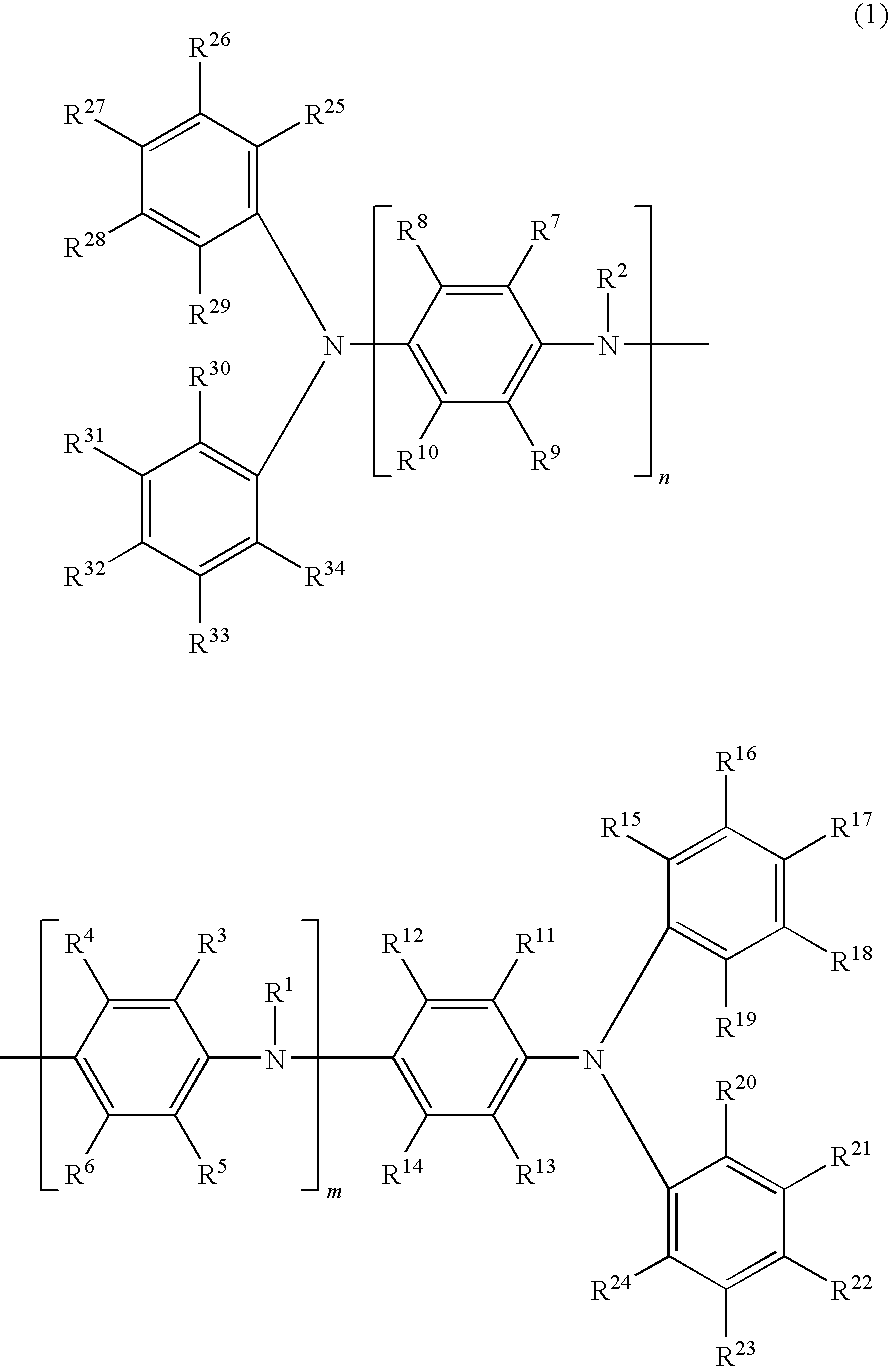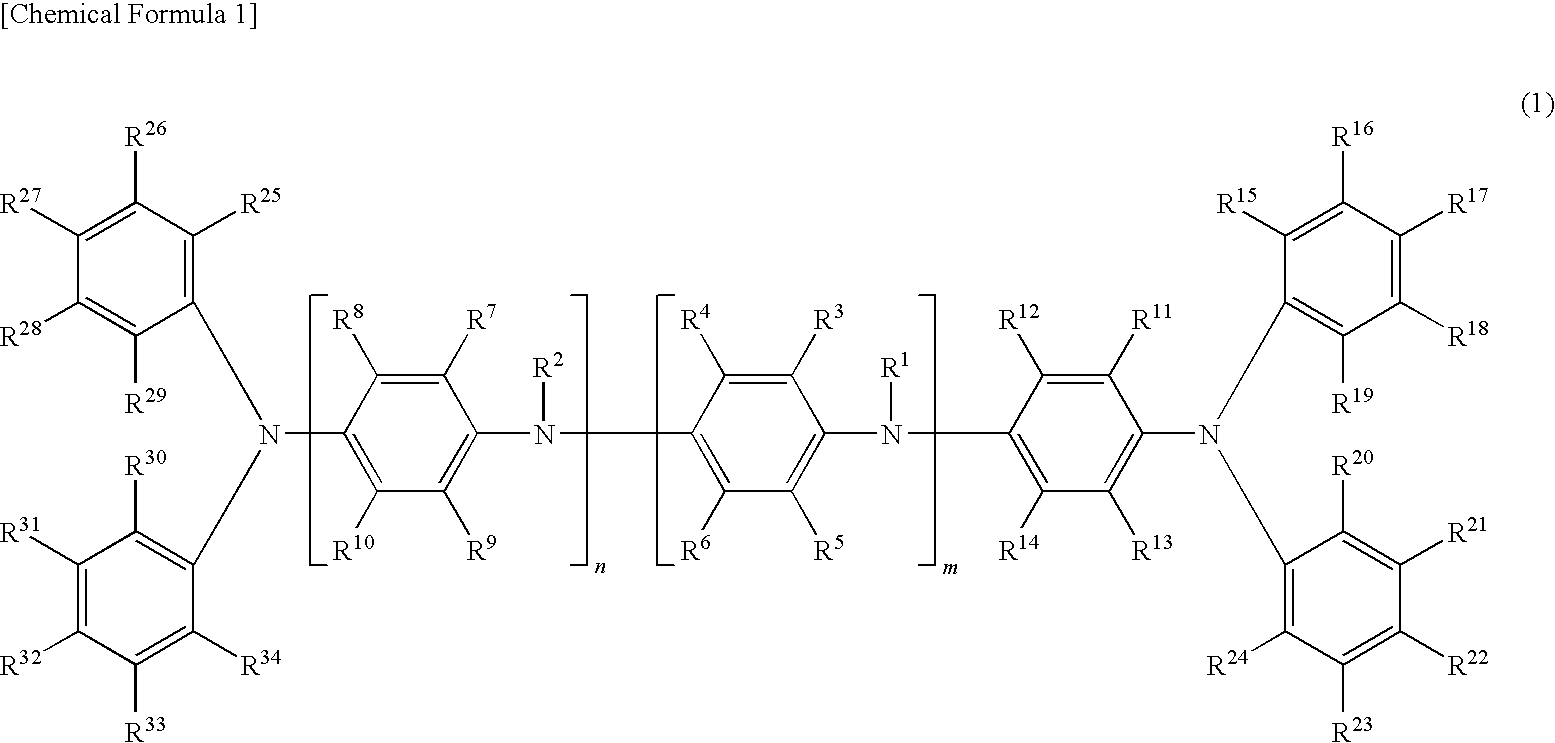Oligoaniline compound
- Summary
- Abstract
- Description
- Claims
- Application Information
AI Technical Summary
Benefits of technology
Problems solved by technology
Method used
Image
Examples
example 1
[1-1] Synthesis of Dibromophenyltetraaniline
[0174]
[0175]In a 500-mL Erlenmeyer flask were placed 20 g (41.19 mmol) of PTA and 300 mL of chloroform. The content was stirred by means of an ellipsoidal stirring chip. (PTA did not dissolve in chloroform but remained suspending.) In a 200-mL beaker was placed 39.72 g (82.38 mmol) of tetrabutylammonium tribromide (TBABr3), which was dissolved in 50 mL of chloroform added later. The resulting solution was added dropwise to the chloroform-PTA solution, and the mixture was stirred for 20 hours at room temperature in the air. Then, the chloroform-PTA solution was transferred to a 1000-mL separatory funnel and washed five times with 100 mL of saturated aqueous solution of sodium thiosulfate. After separation, the chloroform layer was transferred to a 500-mL Erlenmeyer flask and then dehydrated with 20 g of anhydrous magnesium sulfate. With the anhydrous magnesium sulfate removed by filtration, the chloroform solution was transferred to a 500-m...
example 2
[2-1] Synthesis of N,N-di-(4-biphenylyl)-benzylamine
[0188]
[0189]In a 100-mL three-neck flask were placed 80 mL of toluene, 42.0 mg (0.187 mmol) of palladium acetate, and an ellipsoidal stirring chip. The two outer necks were closed with septum caps and the center neck was provided with a reflux coiled condenser. To the top of the condenser was attached a three-way stopcock, to which is attached a balloon filled with nitrogen gas. The atmosphere in the flask was replaced three times by nitrogen gas supplied from the balloon with the help of a vacuum pump. Into the flask was injected 0.6 g (3 mmol) of tris-t-butylphosphine by means of a syringe, followed by stirring for five to ten minutes at room temperature. The flask was further charged with 2.04 mL (18.7 mmol) of benzylamine, 10.0 g (42.9 mmol) of 4-dibromophenyl, and 4.3 g (44.9 mmol) of sodium t-butoxide. With the flask placed on an oil bath, the solution therein was gradually heated to 120° C. with stirring. After 20 hours, the...
example 3
[3-1] Synthesis of 4-Bromodiphenylamine
[0201]
[0202]In a 1000-mL Erlenmeyer flask were placed 20 g (118.1 mmol) of diphenylamine, 500 mL of chloroform, and an ellipsoidal stirring chip. In a 500-mL beaker was placed 113.8 g (236.2 mmol) of tetrabutylammoniumtribromide (TBABr3), which was dissolved in 200 mL of chloroform added later. The resulting solution was added dropwise to the chloroform-diphenylamine solution, and the mixture was stirred for 20 hours at room temperature in the air. Then, the chloroform-diphenylamine solution was transferred to a 1000-mL separatory funnel and washed seven times with 100 mL of saturated aqueous solution of sodium thiosulfate. The organic layer was transferred to a 1000-mL Erlenmeyer flask and then dehydrated with 100 g of anhydrous magnesium sulfate. With the anhydrous magnesium sulfate removed by filtration, the chloroform solution was transferred to a 1000-mL eggplant-shaped flask and freed of chloroform by means of an evaporator. The resulting...
PUM
| Property | Measurement | Unit |
|---|---|---|
| Mass | aaaaa | aaaaa |
| Efficiency | aaaaa | aaaaa |
| Transport properties | aaaaa | aaaaa |
Abstract
Description
Claims
Application Information
 Login to View More
Login to View More - R&D
- Intellectual Property
- Life Sciences
- Materials
- Tech Scout
- Unparalleled Data Quality
- Higher Quality Content
- 60% Fewer Hallucinations
Browse by: Latest US Patents, China's latest patents, Technical Efficacy Thesaurus, Application Domain, Technology Topic, Popular Technical Reports.
© 2025 PatSnap. All rights reserved.Legal|Privacy policy|Modern Slavery Act Transparency Statement|Sitemap|About US| Contact US: help@patsnap.com



